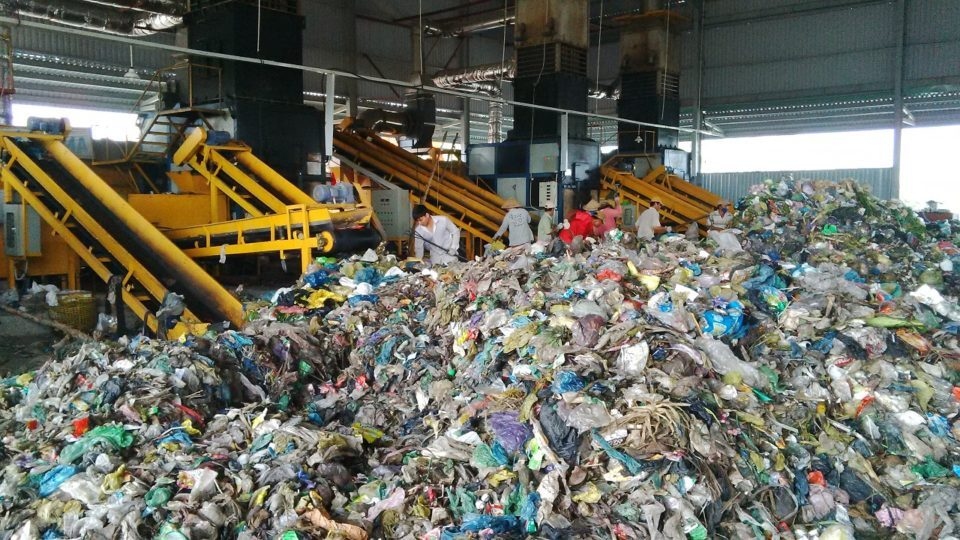Overcoming the challenge: Effective solid waste management on a budget
VOV.VN - Technology plays an important role in treating and managing solid waste to keep the environment green and clean, however choosing a cost-effective technology is not easy for local management agencies.

On 21 February 2005, the Leuwigajah landfill in Bandung, Indonesia, experienced a devastating methane gas explosion and subsequent landslide that left resident and emergency responders traumatised. The incident led to the closure of the landfill, and its functions were moved to the Sarimukti landfill, which is now set to close soon. The tragedy serves as a painful reminder that we must take better care of our solid waste facilities.
Many open dumping sites are found not only in Indonesia, raising concerns about solid waste management. In a recent report by CNN, the Brahmapuram landfill in India was found to have burned, causing harm to the residents and firefighters who fainted from the methane gas produced by the incident.
The Lewuigajah incident’s lesson is that we must be more proactive about trash management, something that the people in Tegal, a city in Central Java, started doing when they asked the Dinas Lingkungan Hidup (Department of Environment) to shut down the TPA Penujah (Penujah final processing site) due to overflowing untreated waste. A similar request was made to the government of TPS Lumintang in Denpasar, Bali, a temporary disposal site prone to landslides and difficult for garbage trucks to navigate during the rainy season.
Opening a dumpsite or rehabilitating an existing one is not an easy task. Regulation of the Minister of Finance of the Republic of Indonesia number 26/PMK.07/2021, concerning funding support for state revenue and expenditure budget for waste management in the regions, allocates Rp500,000 (about US$32) for waste processing in municipalities. The amount is for recycling, reducing, sorting, and treating trash of up to one tonne.
To mitigate the lack of funds, at least three landfill models are being considered: anaerobic, semi-aerobic, and aerobic landfills. Judging from Indonesia’s topography and cultural similarities, it is possible to utilise the semi-aerobic landfill mechanism used in the Ampang Jajar Landfill in Malaysia and the Nam Son Landfill in Vietnam.
Known as the Fukuoka method, the model installs perforated collection pipes and similarly styled vertical gas vent pipes at the bottom of the landfill, allowing the quick removal of leachates. By keeping the aerobic environment at the end of the collection pipes and combining it with the heat from the fermenting waste, good airflow is naturally maintained without the need for additional technologies.
A semi-aerobic landfill would be a cheaper alternative because materials such as bamboo could be sourced locally and be used as leachate-collection pipes. For the gas ventilation system combined with concrete pipes for air recirculation, landfills could utilise steel drums, which are easily found or can be fabricated with used materials.
A cheap alternative does not mean reduced benefits. Processing methane gas into carbon dioxide is significant in slowing down the greenhouse effect by turning the poisonous gas into a lesser evil for the ozone layer. The alternative reduces the possibility of methane gas exploding and endangering landfill workers and residents living near the facilities. The waste repository would have a built-in processing system to protect groundwater and rivers from landfill leachates.
The alternative, however, is not fool proof. Without a strong recycling facility to support the waste repository, the landfill will continue to contain heterogeneous waste, which, in turn, would prevent the semi-aerobic landfill from functioning properly without risking leakage of microplastics into the sea or groundwater.
Of course, other factors can be considered in solid waste management.
First, although recycling wins in ensuring the success of the Fukuoka method, it is always a chicken-and-egg question: What should come first—building facilities or sorting garbage at home? Unfortunately, the rate of return of recycling or the technology to turn recyclables into energy is not always profitable, deterring some countries from building more diverse recycling facilities. But if Indonesia commits to recycling by persistently sorting waste, the increase in demand will force municipalities to build diversified recycling facilities.
Second, setting aside additional money for landfill education in regional budgets would help maintain the health and safety of surrounding landfill residents. Investing in education means protecting the welfare of the people, who are primarily landfill workers and nearby residents. Education should include teaching people about the direct dangers of landslides and indirect effects, such as greenhouse gasses produced in landfills. High methane content can result not only in deadly explosions but also cause long-term bronchial, atrial, and neural effects. Identifying and resolving problems could be included in the curriculum, along with emergency numbers to prevent scenarios that could endanger those who frequent landfills. This knowledge can promote the importance of sorting, for instance, combustibles and organics.
Third, make the websites at all government levels user-friendly. Data need to be easily accessible to enable people to help the government solve waste issues by comparing what has and has not been tried. We certainly are not lacking thinkers and think-tanks in our midst.
However, we can only work together if we have transparent reports, budgets, and resources. Soekarno, one of Indonesia’s founding fathers, once said we should not leave our history behind. We, too, need to take the lessons from the Leuwigajah incident to heart and strive to never let garbage go untreated, for the benefit of our planet and the safety of our people.
